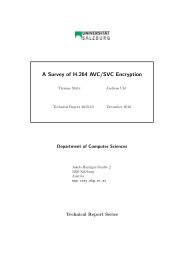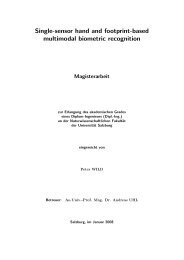Pit Pattern Classification in Colonoscopy using Wavelets - WaveLab
Pit Pattern Classification in Colonoscopy using Wavelets - WaveLab
Pit Pattern Classification in Colonoscopy using Wavelets - WaveLab
You also want an ePaper? Increase the reach of your titles
YUMPU automatically turns print PDFs into web optimized ePapers that Google loves.
4.3 Structure-based classification<br />
tree distance<br />
B1 0,1<br />
B2 0,0833<br />
B3 0,0583<br />
B4 0,8552<br />
Table 4.2: Distances to tree A accord<strong>in</strong>g to figure 4.2 us<strong>in</strong>g “distance by decomposition<br />
str<strong>in</strong>gs”<br />
where n is the number of different nodes among the two quadtrees T 1 and T 2 and d i is the<br />
depth level of the i-th different node.<br />
It is obvious that the distance for equal trees is 0 s<strong>in</strong>ce <strong>in</strong> that case the sum is zero. It can<br />
also easily be seen that the distance for two completely different quadtrees never exceeds 1<br />
s<strong>in</strong>ce for two completely different quadtrees n becomes |DS 1 | + |DS 2 | which can also be<br />
written as<br />
d(T 1 , T 2 ) =<br />
∑ n<br />
i=1<br />
n<br />
1<br />
d i<br />
(4.54)<br />
S<strong>in</strong>ce 1 d i<br />
is always less than 1 it is easy to see that the upper part of the fraction is always<br />
less than n. Therefore the distance is always less than 1.<br />
In table 4.2 the result<strong>in</strong>g distances accord<strong>in</strong>g to figure 4.2 us<strong>in</strong>g “distance by decomposition<br />
str<strong>in</strong>gs” are shown. Aga<strong>in</strong>, just like the previous method, the results <strong>in</strong> the table clearly<br />
show, that, as <strong>in</strong>tended, differences <strong>in</strong> the upper levels of a quadtree contribute more to the<br />
distance than differences <strong>in</strong> the lower levels.<br />
Compared to the distances <strong>in</strong> table 4.1, the results <strong>in</strong> table 4.2 are quite similar as long<br />
as the number of differences between two trees is low. But the more differences between<br />
two trees are present, the more different are the distance values between the two presented<br />
methods. The method based on decomposition str<strong>in</strong>gs shows significantly higher distance<br />
values if there are many differences between the trees.<br />
4.3.3.3 Best basis method us<strong>in</strong>g structural features (BBS)<br />
This method is very similar to the best-basis method presented section 4.2.1.1 <strong>in</strong> that it is<br />
also based on the best-basis algorithm. But <strong>in</strong> contrast to the best-basis method, this method<br />
uses feature extractors which are not based on the coefficients of the subbands result<strong>in</strong>g from<br />
a wavelet decomposition but on the decomposition structures result<strong>in</strong>g from the best-basis<br />
algorithm. For this we developed three dist<strong>in</strong>ct feature extractors.<br />
51








